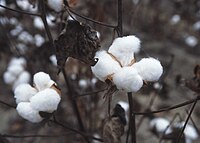
Photo from wikipedia
Abstract The large-scale surface enhanced Raman scattering (SERS) cotton fabrics were fabricated based on traditional woven ones using a dyeing-like method of vat dyes, where silver nanoparticles (Ag NPs) were… Click to show full abstract
Abstract The large-scale surface enhanced Raman scattering (SERS) cotton fabrics were fabricated based on traditional woven ones using a dyeing-like method of vat dyes, where silver nanoparticles (Ag NPs) were in-situ synthesized by ‘dipping-reducing-drying’ process. By controlling the concentration of AgNO3 solution, the optimal SERS cotton fabric was obtained, which had a homogeneous close packing of Ag NPs. The SERS cotton fabric was employed to detect p-Aminothiophenol (PATP). It was found that the new fabric possessed excellent reproducibility (about 20%), long-term stability (about 57 days) and high SERS sensitivity with a detected concentration as low as 10−12 M. Furthermore, owing to the excellent mechanical flexibility and good absorption ability, the SERS cotton fabric was employed to detect carbaryl on the surface of an apple by simply swabbing, which showed great potential in fast trace analysis. More importantly, this study may realize large-scale production with low cost by a traditional cotton fabric.
Journal Title: Applied Surface Science
Year Published: 2018
Link to full text (if available)
Share on Social Media: Sign Up to like & get
recommendations!